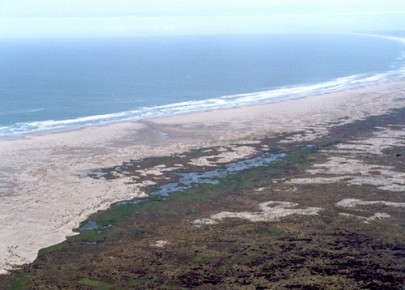Damp sand plains
In this section

Damp sand plains, Westland (Peter Johnson)
Damp sand plains are flat areas where wind has removed sand down to a level where the water is permanently just below the surface or occasionally above it. This stabilises the sand and prevents the surface being lowered further. They often form between a series of sand dunes. This system can grade upslope into dune deflation hollows where the sand is excessively drained for longer periods, and down slope into dune slacks where the water table is nearly permanently at the surface and may be covered during high tides. Damp sand plains are initially colonised by small plants such as sand carex (Carex pumila), Selliera radicans and Gunnera dentata, and then by progressively taller plants over time such as knobby club rush (Ficinia nodosa).
Notable flora and fauna
Threatened and rare plants include the nationally critical Gunnera hamiltonii, Pimelea actea and Sebaea ovata. Nationally endangered species include the pygmy clubrush (Isolepis basilaris) and Myosotis pygmaea var. minutiflora. Nationally vulnerable species include the coastal cress (Lepidium flexicaule), New Zealand iris (Libertia peregrinans), Mazus novae-zelandiae subsp. impolitus and Myosotis pygmaea var pygmaea. Declining species include the sand spike sedge (Eleocharis neozelandica), Ranunculus recens var. recens, Gunnera arenaria, dwarf woodrush (Luzula celata) and Selliera rotundifolia. Naturally uncommon species include the creeping eyebright (Euphrasia repens), Chatham Island geranium (Geranium traversii), sand musk (Mazus arenarius), Stewart Island forget-me-not (Myosotis rakiura), Traill’s button daisy (Leptinella traillii subsp. traillii) and southern sand daphne (Pimelea lyallii).
Threat status
Critically endangered (Holdaway et al. 2012)
Threats
Many exotic species are present, e.g. hawkbit (Leontodon taraxacoides), buttercup (Ranunculus repens), creeping bent (Agrostis stolonifera), Yorkshire fog (Holcus lanatus), and several clovers (particularly Trifolium spp. and Lotus spp.) and in some places, the large pampas grasses (Cortaderia jubata and C. selloana) are invasive. Holly-leaved senecio (Senecio glastifolius) is an increasing problem.
Coastal development poses a threat: damp sand plains have been converted into agricultural land and development is common due to demand for coastal property, but some remote areas are less affected. Due to development, planting exotic species, particularly marram grass (Ammophila arenaria) for stabilisation against erosion has been common, which alters natural vegetation patterns.
Vehicle traffic, especially off-road vehicles, is a problem in some areas.
Climate change poses a threat due to increased erosion from rising sea levels.
Where do they occur?
Damp sand plains are found in association with sand dune systems throughout the New Zealand coast. They are particularly common in the western North Island from the Manawatu region to Wanganui, especially between the Manawatu and Rangitikei rivers where an extensive flat hinterland has allowed the dunes to spread inland. They also occur in Northland and on Stewart Island and Chatham Island.
Further reading
Champion PD, Reeves PN 2009. Factors causing dune ephemeral wetlands to be vulnerable to weed invasion. DOC Research & Development Series 310. Wellington, Department of Conservation. 53 p.
Esler AE 1969. Manawatu sand plain vegetation. Proceedings of the New Zealand Ecological Society 16: 32-35.
Esler AE 1970. Manawatu sand dune vegetation. Proceedings of the New Zealand Ecological Society 17: 41-47.
Johnson P, Rogers G 2006. Dune wetlands and their vegetation dynamics. Landcare Research Contract Report to the Department of Conservation, Wellington.


